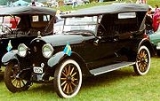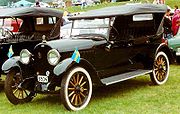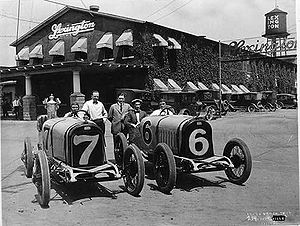
Lexington Automobile
Encyclopedia


Connersville, Indiana
At the 2000 census, there were 15,411 people, 6,382 households and 4,135 families residing in the city. The population density was 1,894.5 per square mile . There were 6,974 housing units at an average density of 857.3 per square mile...
, from 1910 to 1927. From the beginning, Lexingtons, like most other Indiana-built automobiles, were assembled cars, built with components from many different suppliers. The Thoroughbred Six and Minute Man Six were popular Lexington models.
Origins
The Lexington Motor Company was founded in 1909 in Lexington, KentuckyLexington, Kentucky
Lexington is the second-largest city in Kentucky and the 63rd largest in the US. Known as the "Thoroughbred City" and the "Horse Capital of the World", it is located in the heart of Kentucky's Bluegrass region...
, by Knisey Stone, a Kentucky race horse promoter. Several months later, the company outgrew its building.
In 1910, a group of Connersville businessmen noted the community had too much tied up in the buggy
Horse and buggy
A horse and buggy or horse and carriage refers to a light, simple, two-person carriage of the late 18th, 19th and early 20th centuries, drawn usually by one or sometimes by two horses...
and carriage
Carriage
A carriage is a wheeled vehicle for people, usually horse-drawn; litters and sedan chairs are excluded, since they are wheelless vehicles. The carriage is especially designed for private passenger use and for comfort or elegance, though some are also used to transport goods. It may be light,...
industry, which was being displaced by the growing use of the automobile. The group enticed the infant Lexington Motor Car Company to relocate from Lexington to a new plant at 800 West 18th Street in the McFarlan
McFarlan Automobile
McFarlan is an American automobile manufactured in Connersville, Indiana from 1909 to 1928 as an outgrowth of the McFarlan Carriage Company founded in 1856 by English-born John B. McFarlan ....
industrial park, with headquarters at 1950 Columbia Avenue. John C. Moore, the company's chief engineer, immediately started on improvements to the Lexington to keep the company ahead of its competition. His 1911 multiple exhaust was reported to give 30 percent more power on less fuel. Each cylinder had a separate exhaust. Dual exhaust pipes and mufflers were used.
The company entered both the Glidden Tour
Glidden Tour
The Glidden Tours were promotional events held during the automotive Brass Era by the American Automobile Association . The AAA, a proponent for safer roads, acceptance of the automobile and automotive-friendly legislation, started the tour to promote public acceptance and bring awareness of their...
and Indianapolis 500
Indianapolis 500
The Indianapolis 500-Mile Race, also known as the Indianapolis 500, the 500 Miles at Indianapolis, the Indy 500 or The 500, is an American automobile race, held annually, typically on the last weekend in May at the Indianapolis Motor Speedway in Speedway, Indiana...
in 1912.
Acquisition and expansion
Financial difficulties were solved in 1913 when E.W. Ansted acquired Lexington to assemble the six-cylinder Howard for a contract with a ChicagoChicago
Chicago is the largest city in the US state of Illinois. With nearly 2.7 million residents, it is the most populous city in the Midwestern United States and the third most populous in the US, after New York City and Los Angeles...
distributor. The resultant company was named Lexington-Howard. In 1915, the named changed back to Lexington Motor Company. The regular four-cylinder engine was supplemented by a light six and a supreme six. With the new Ansted engines, its cars became modern and powerful. In 1916, Lexington was using the Continental
Continental Motors Company
Continental Motors Company was an American engine and automobile manufacturer. The company produced engines for various independent manufacturers of automobiles, tractors, and stationary equipment from the 1900s through the 1960s. Continental Motors also produced Continental-branded automobiles in...
engine.
Lexington's first plant expansion was in 1915. A factory building was erected just north of the office. Also built at the same time was a 100 feet (30.5 m) smokestack with the Lexington name in lighter color bricks. Four years later the company built a 106050 sq ft (9,852 m²) assembly building just west of the office.
In 1917, Moore put together a new frame with a rigid box cross-section that eliminated the problem of jammed doors caused by frame flexing. This car also had an emergency brake affixed to the drive shaft. In 1918, Lexington autos featured hardtop enclosures made by the Rex Manufacturing Company, also of Connersville.
Also in 1918, the newly formed Ansted Engineering Company acquired Teetor-Harley Motor Corporation of Hagerstown, Indiana
Hagerstown, Indiana
Hagerstown is a town in Jefferson Township, Wayne County, Indiana, United States. As of the 2010 census, the population was 1,787.-Geography:Hagerstown is located at ....
. In 1919, the 85306 sq ft (7,925 m²) Ansted Engine building was erected just north of the Lexington plant and extended to 21st Street. The combined Lexington and Ansted facilities measured three blocks long and two blocks wide totaling 270000 sq ft (25,083.8 m²) of floor space.
Heyday
Two short-wheelbase race cars with the powerful Ansted engine were built by Lexington for the 1920 Pikes PeakPikes Peak
Pikes Peak is a mountain in the Front Range of the Rocky Mountains, west of Colorado Springs, Colorado, in El Paso County in the United States of America....
hill climb. The cars placed first and second in their initial outing and brought home the Penrose trophy. Again in 1924, Otto Loesche won, with a 18 minute 15 second dash and brought the trophy home for keeps. The Penrose trophy is on display at the Reynolds Museum on Vine Street.
The formation of the United States Automotive Corporation was announced by President Frank B. Ansted at the New York Auto Show on January 12, 1920. It was a $10 million merger with the Lexington, the Ansted Engineering Company, and Connersville Foundry Corporation, all from Connersville, plus the Teetor-Harley Motor Corporation of Hagerstown. 1920 marked the high point of Lexington production with over 6,000 built.
On December 16, 1921, William C. Durant
William C. Durant
William Crapo "Billy" Durant was a leading pioneer of the United States automobile industry, the founder of General Motors and Chevrolet who created the system of multi-brand holding companies with different lines of cars....
, founder of General Motors
General Motors
General Motors Company , commonly known as GM, formerly incorporated as General Motors Corporation, is an American multinational automotive corporation headquartered in Detroit, Michigan and the world's second-largest automaker in 2010...
and former GM president, ordered 30,000 Ansted engines for his new Durant Six, being built in Muncie, Indiana
Muncie, Indiana
Muncie is a city in Center Township, Delaware County in east central Indiana, best known as the home of Ball State University and the birthplace of the Ball Corporation. It is the principal city of the Muncie, Indiana, Metropolitan Statistical Area, which has a population of 118,769...
by Durant Motors, Inc. Late in 1921, Alanson P. Brush (designer of the Brush Runabout and consulting engineer to General Motors) sued the company, alleging the Ansted engine infringed a number of his patents. The negative publicity hurt.
Records show in 1922, United States Automotive Corporation, Lexington's parent company, owned ten different factories building parts for its cars. Auto historian Henry Blommel notes, "It was a great alliance of parts-making plants that found the culmination of its efforts in the finished Lexington car."
Phaseout
The post-World War IWorld War I
World War I , which was predominantly called the World War or the Great War from its occurrence until 1939, and the First World War or World War I thereafter, was a major war centred in Europe that began on 28 July 1914 and lasted until 11 November 1918...
recession of the early twenties destroyed many American automobile manufacturers. Lexington Motor Car Company and United States Automotive Corporation were affected by these recessionary events. Production in 1922 plummeted to roughly a third that of 1920. In 1923, Ansted Engine Company entered receivership, with Durant as a principal shareholder. Lexington also entered receivership in 1923. In 1926 and 1927, respectively, E.L. Cord's Auburn Automobile
Auburn Automobile
Auburn was a brand name of American automobiles produced from 1900 through 1936.-Corporate history:The Auburn Automobile Company grew out of the Eckhart Carriage Company, founded in Auburn, Indiana, in 1875 by Charles Eckhart...
Company purchased Ansted Engine and the Lexington Motor Car Company. The Lexington was soon phased out.
Cord then invested $2 million in plant and production facilities. The new manufacturing plant was comparable to the most modern assembly plants anywhere in the world. It consisted of 20 buildings on 82 acres (331,842.5 m²), and 1500000 square feet (139,354.6 m²) of manufacturing area available for the production of 400 bodies and 250 completed cars per day. Sheet metal, wood, engines and other materials entered the plant on the northeast side, and the completed car was delivered to the customer near the southwest corner.
Yearly model changes
The early Lexingtons of 1910 to 1913 were four-cylinder automobiles built on 116 in (2,946 mm) to 122 in (3,099 mm) wheelbaseWheelbase
In both road and rail vehicles, the wheelbase is the distance between the centers of the front and rear wheels.- Road :In automobiles, the wheelbase is the horizontal distance between the center of the front wheel and the center of the rear wheel...
s, with body styles including 2 seat runabout
Runabout (car)
Runabouts were a popular car body style at the beginning of the 20th Century. They were small, inexpensive, open cars. Most runabouts had just a single row of seats, providing seating for two passengers. Many also had a tonneau at the rear to provide optional seating for four or five...
s and roadster
Roadster
A roadster is a two-seat open car with emphasis on sporty handling and without a fixed roof or side weather protection. Strictly speaking a roadster with wind-up windows is a convertible but as true roadsters are no longer made the distinction is now irrelevant...
s, 5 and 7 passenger tourer
Touring car
A touring car, or tourer, is an open car seating five or more. Touring cars may have two or four doors. Often, the belt line is lowered in the front doors to give the car a more sportive character. They were often fitted with a folding roof and side curtains. Engines on early models were either in...
s, and limousine
Limousine
A limousine is a luxury sedan or saloon car, especially one with a lengthened wheelbase or driven by a chauffeur. The chassis of a limousine may have been extended by the manufacturer or by an independent coachbuilder. These are called "stretch" limousines and are traditionally black or white....
s. The year 1914 marked the introduction of a six-cylinder auto on a 130" (3302 mm) wheelbase. In 1915, the 29 hp (22 kW) Light Six rode on a 128 in (3251 mm) wheelbase and the 41 hp (31 kW) Supreme Six on 130 in (3302 mm), offering a range of body styles: 3 seat roadster, 5, 6, and 7 passenger tourer, and 7 passenger limousine. In 1916, the Thoroughbred Six sold for US$2875, the Minute Man Six tourer US$1185 and convertible
Convertible
A convertible is a type of automobile in which the roof can retract and fold away having windows which wind-down inside the doors, converting it from an enclosed to an open-air vehicle...
sedan US$1350. Both offered electric horns. By comparison, the Enger 40 was US$2000, the FAL was US$1750, the Oakland 40 US$1600, the Cole 30 and Colt Runabout was priced at US$1500, the Oldsmobile
Oldsmobile
Oldsmobile was a brand of American automobile produced for most of its existence by General Motors. It was founded by Ransom E. Olds in 1897. In its 107-year history, it produced 35.2 million cars, including at least 14 million built at its Lansing, Michigan factory...
Runabout
Oldsmobile Curved Dash
The gasoline powered Curved Dash Oldsmobile is credited as being the first mass-produced automobile, meaning that it was built on an assembly line using interchangeable parts. It was introduced by the Oldsmobile company in 1901 and produced through 1907...
US$650, Western
Western Tool Works (automobile company)
Western Tool Works was a pioneering brass era automobile manufacturer in Galesburg, Illinois.Western in 1905 produced the Gale Model A, an open roadster, for sale at US$500, which was less than high-volume Oldsmobile Runabout, at US$650, the Ford "Doctor's Car" at US$850, or the Holsman high...
's Gale Model A US$500, the Brush Runabout
Brush Motor Car Company
This article is about a USA auto-maker. For the British rail-locomotive company, see Brush TractionBrush Motor Company, or the "Brush Runabout Company," based in Detroit, Michigan, was founded by Alanson Partridge Brush , who designed a light car with a wooden chassis This article is about a USA...
US$485, and Ford
Ford Motor Company
Ford Motor Company is an American multinational automaker based in Dearborn, Michigan, a suburb of Detroit. The automaker was founded by Henry Ford and incorporated on June 16, 1903. In addition to the Ford and Lincoln brands, Ford also owns a small stake in Mazda in Japan and Aston Martin in the UK...
's Model T
Ford Model T
The Ford Model T is an automobile that was produced by Henry Ford's Ford Motor Company from September 1908 to May 1927...
already US$440.
For 1919, there were new, enclosed bodies with names like Coupelet, Sedanette, and Salon Sedan all with six-cylinder engines and a 122 in (3099 mm) wheelbase.
There were two series of 1921 and 1922 Lexingtons: Series S, a 47 hp (35 kW) six-cylinder on a 122 in (3099 mm) wheelbase, and Series T, a 60 hp (45 kW) six on a 128 in (3251 mm) wheelbase; body styles included 5 and 7 passenger tourer, sedan, coupe
Coupé
A coupé or coupe is a closed car body style , the precise definition of which varies from manufacturer to manufacturer, and over time...
, and sedanette, and 7 passenger Salon Sedan. In 1924 and 1925, Lexington again offered two versions: the Concord, a 65 hp (48 kW) six on a 119 in (3023 mm) wheelbase, and the Minute Man, a 72 hp (54 kW) six on a 123 in (3124 mm) wheelbase; body styles included 5 and 7 passenger tourer, sedan, and coupe, 5 passenger Royal Coach, and 5 passenger Brougham
Brougham
Brougham could betransport:* Brougham , a single-engined aircraft of the 1920s and 1930s.* Brougham , a light four-wheeled horse-drawn carriage* Brougham , an automobile with a similar style; later applied to any luxurious car...
. In 1926 and 1927, Lexington offered the Model 6-50, a with same engine and wheelbase of the Concord, in 4 passenger roadster or landaulet
Landaulet
A landaulet or landaulette is a car body style, "an enclosed sedan or coupé with a folding top at the extreme rear quarter, over the rear seat."...
, and a 5 passenger phaeton
Phaeton body
A Phaeton is a style of open car or carriage without proper weather protection for passengers. Use of this name for automobiles was limited to North America or its products....
, sedan, or landau sedan.
Production totals
The following lists the number of Lexingtons in each year, from 123 in 1909 up to 6,128 in 1920, followed by a decline to 183 in 1926, the final year.1909 - 123; 1910 - 625: 1911 - 939; 1912 - 1,013; 1913 - 1,915; 1914 - 1,612; 1915 - 2,814; 1916 - 3,115; 1917 - 3,917; 1918 - 4,123; 1919 - 3,124; 1920 - 6,128; 1921 - 4,236; 1922 - 2,114; 1923 - 1,330; 1924 - 498; 1925 - 339; 1926 - 183

